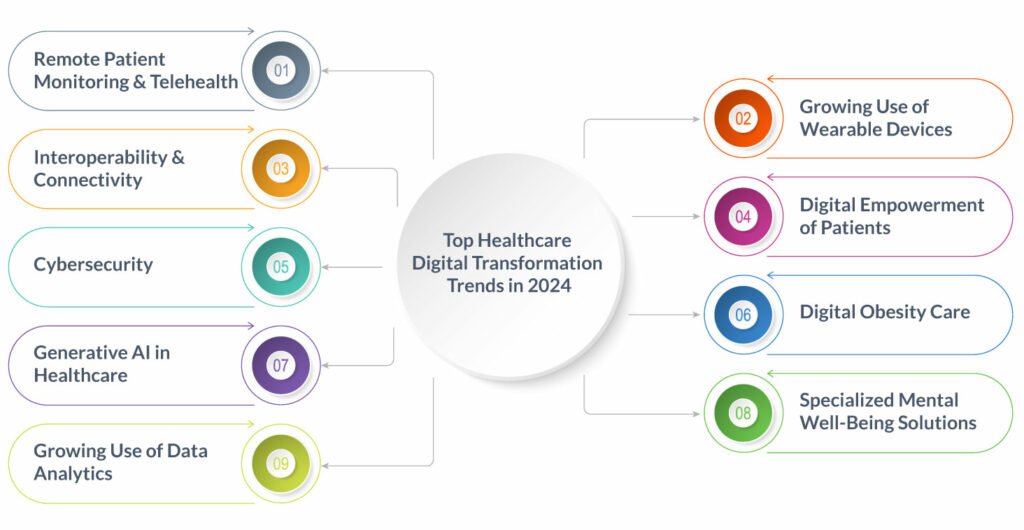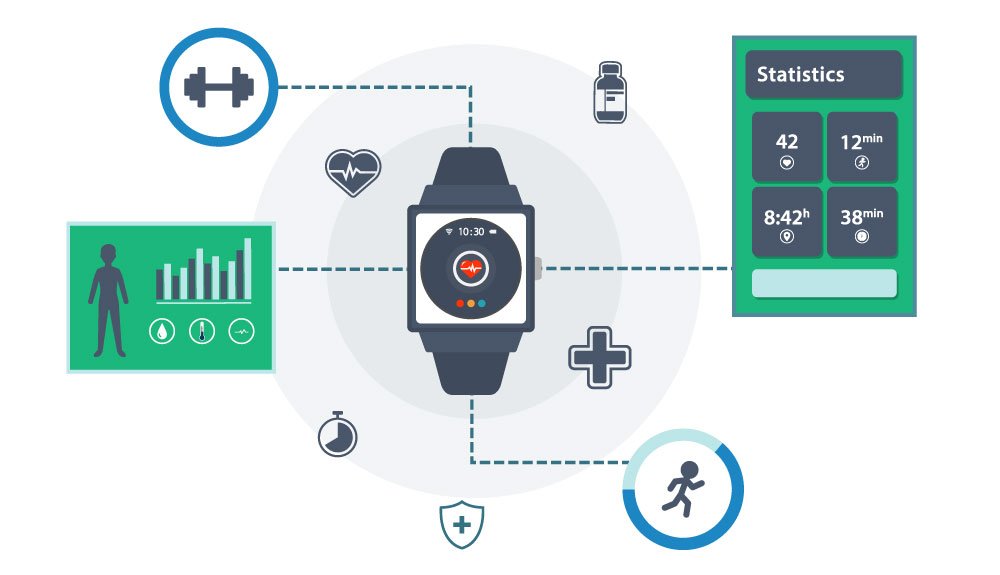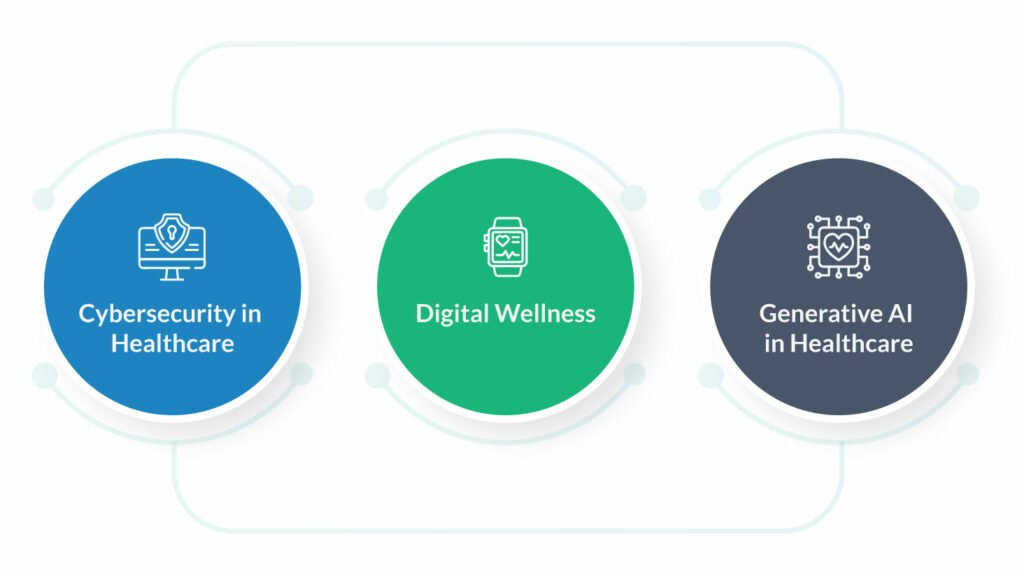Digital Health Trends in 2024: Shaping the Future of Healthcare
Table of Contents
Digital health is the future of healthcare. It is not just a buzzword, but a revolution that is reshaping the very foundation of how we approach healthcare. Imagine a world where seeing your doctor is as easy as picking up your phone, where your smartwatch tells you more about your health than a routine check-up, and where AI helps diagnose illnesses before you even feel the symptoms. This isn’t the plot of a sci-fi movie; it’s the reality of healthcare in 2024, powered by a booming digital health market that’s set to break the $500 billion mark by 2028. The growth isn’t just rapid; it’s exponential, with every new tool and app bringing us one step closer to a world where healthcare knows no boundaries.
From AI-driven diagnostics to telemedicine breaking geographical barriers, in the coming years, we will be witnessing the incredible ways technology is making healthcare more accessible, personalized, and efficient.
In this context, we explore the key digital health trends that are set to redefine the standards of healthcare delivery and patient engagement in 2024.
Top Healthcare Digital Transformation Trends in 2024

Remote Patient Monitoring and Telehealth
The telehealth and remote patient monitoring (RPM) sectors are experiencing significant growth and innovation, driven by various factors like – the need for more cost-effective healthcare services, the increasing geriatric population, and the rising prevalence of chronic conditions. These factors are pushing healthcare providers to adopt telehealth and RPM technologies to improve clinical outcomes and make healthcare more accessible and efficient.
The digital patient monitoring devices (like Weight Monitoring, Temperature Monitoring) market, which encompasses RPM, was valued at $65.8 billion in 2023, with expectations to grow at a CAGR of 28.3% from 2024 to 2032, reaching $620.2 billion by 2032. This growth underscores the increasing demand for remote healthcare services globally.
Remote Patient Monitoring (RPM) has emerged as a cornerstone in the digital health domain, allowing healthcare providers to monitor patients outside of conventional clinical settings. This trend is particularly beneficial for chronic disease management, post-operative care, and elderly care, providing real-time data that leads to timely interventions and reduced hospital readmissions.
Telehealth has transcended its pandemic-era emergence as a necessity, becoming a staple in the healthcare delivery model. In 2024, its integration with remote patient monitoring (RPM) systems is elevating patient care, allowing healthcare providers to track patients’ health in real time, reduce hospital readmission rates, and provide timely interventions. This trend not only makes healthcare more accessible but also more proactive, as RPM devices can detect health issues before they become critical.

This landscape indicates a rapidly evolving sector where telehealth and RPM are becoming integral components of the healthcare system, driven by technological advancements and the need to provide more patient-centered, efficient, and accessible care.
Interoperability and Connectivity
The need for healthcare interoperability solutions is continuously growing due to substantial investments in digitalizing healthcare infrastructure and the high adoption of electronic health records (EHRs). The global healthcare interoperability solutions market is projected to reach USD 6.2 billion by 2027, growing at a compound annual growth rate (CAGR) of 12.9% from 2022 to 2027.
Focusing on different types of interoperability solutions, such as EHR interoperability, lab system interoperability, and healthcare information exchange, emphasizes the diverse needs of the healthcare sector for seamless data exchange and integration. Enhanced connectivity also ensures that patient data is accessible and usable across various platforms, improving care coordination and reducing the likelihood of medical errors.
Cybersecurity
The healthcare sector experienced a 55% increase in cyberattack incidents in 2020 compared to 2019, as reported by IBM. As healthcare increasingly relies on digital platforms, the need for robust cybersecurity measures has never been more critical. Protecting sensitive patient data from cyber threats is a top priority, with healthcare institutions investing in advanced security protocols to prevent data breaches and ensure patient trust.
A notable example illustrating the impact of cybersecurity breaches in healthcare is the Anthem cyberattack, which affected nearly 78.8 million individuals. This breach, primarily caused by a phishing attack, compromised a wide range of personal information, highlighting such incidents’ extensive financial, organizational, and personal repercussions. In response, Anthem invested heavily in cybersecurity improvements, spending $260 million on various security enhancements
The financial impact of cyberattacks in healthcare is particularly pronounced, with the average cost of a healthcare data breach reaching $10.1 million, the highest across industries. This figure represents a significant increase from previous years, emphasizing the escalating costs associated with securing healthcare data and responding to breaches. According to a report by Meticulous Research, the global healthcare cybersecurity market is expected to grow from USD 8.6 billion in 2019 to USD 16.1 billion by 2025, at a CAGR of 11.0%
These developments indicate the growing need for healthcare organizations to adopt comprehensive and unified cybersecurity strategies.
Growing Use of Wearable Devices
Wearable devices in healthcare are experiencing rapid growth and innovation, significantly impacting how healthcare is delivered and personalized. Deloitte Global predicts a significant increase in the adoption of consumer health and wellness wearable devices, projecting shipments to reach nearly 440 million units by the end of 2024.
The devices like smartwatches and medical-grade “smart patches” are becoming more sophisticated, enabling continuous monitoring and management of chronic health conditions, as well as the detection of symptoms for serious illnesses. For example, smartwatches now feature sensors for continuous health monitoring, such as heart rate and blood oxygen saturation, which became particularly relevant during the COVID-19 pandemic. Smart patches, on the other hand, offer more targeted health monitoring and medication delivery, with some employing minimally invasive methods to provide accurate health data directly from the skin.

As wearable technology continues to evolve, it holds the potential to advance healthcare by making it more accessible, personalized, and proactive, aligning with broader trends toward digital health and preventive medicine.
Generative AI in Healthcare
Generative AI is poised to significantly impact the healthcare sector in 2024, with transformative benefits anticipated across various domains, from remote patient monitoring to telemedicine, and from administrative tasks to clinical decision-making. The integration of Generative AI in healthcare is expected to improve patient care by enabling real-time monitoring through wearable devices equipped with AI algorithms, offering early warnings for health complications, and reducing hospital readmissions. AI-powered virtual assistants could also enhance telemedicine by providing personalized medical advice, thereby improving healthcare accessibility. Also, by analyzing vast datasets, generative AI can identify patterns and generate insights that human researchers might overlook, accelerating the pace of medical advancements.
Growing Use of Data Analytics
Data analytics is becoming increasingly integral to healthcare, enabling providers to make informed decisions based on comprehensive data analysis. This trend is driving improvements in patient care, operational efficiency, and health outcomes. Within this, predictive analytics plays a crucial role in personalized medicine, early risk detection, and intervention strategies. For example, Predictive analytics tools are used in hospitals to forecast patient admissions and manage staffing levels. A study found that the use of predictive analytics in a Chicago hospital reduced patient wait times by 15-20%.
The global market size reached USD 30.9 billion in 2023 and is anticipated to grow at a CAGR of 23.1% during 2024-2032, reaching a value of USD 198.9 billion by 2032. This growth is driven by the increasing demand for data-driven decision-making and the need to address unpredictable obstacles in healthcare.
Digital Empowerment of Patients
In 2024, patient empowerment is increasingly central to healthcare trends, driven by a more collaborative partnership between patients and healthcare providers. Digital tools empower patients, providing access to their health information, telemedicine consultations, and online health resources. Technologies like online scheduling, patient portals, and clinical chatbots are providing patients with access to their health information and care pathways.
Patient empowerment is changing the traditional doctor-patient dynamic, with patients now accessing their health data and even proposing treatment plans based on information found online. This trend is especially pronounced among younger populations, with a significant percentage of 18 to 34-year-olds actively engaging with their healthcare providers based on their online research.
Digital Obesity Care
Digital healthcare technologies are increasingly being recognized for their potential in addressing the concern of obesity through innovative, personalized care strategies. These digital interventions include tailored nutritional and physical activity plans, behavioral coaching, and continuous remote health monitoring, presenting a scalable and effective method for obesity management. A noteworthy publication in the Journal of the American Medical Association (JAMA) revealed that participants engaged in digital health programs exhibited superior weight loss outcomes in comparison to those not utilizing such interventions.
Furthermore, the digital therapeutics sector, inclusive of applications designed for obesity and weight management, is anticipated to witness significant growth, with projections estimating its value to reach USD 13.8 billion by 2027. This represents a compound annual growth rate (CAGR) of 26.1% from 2020 to 2027, as reported by Grand View Research.
Specialized Mental Well-Being Solutions
The mental health domain is currently experiencing significant advancements with the introduction of digital interventions designed to cater to a diverse array of needs, ranging from stress alleviation to the treatment of more profound psychological conditions. These innovative digital platforms are providing accessible and non-judgmental spaces for individuals in pursuit of mental health support, thereby facilitating a shift towards more inclusive mental health care.
The global market for digital mental health solutions is projected to experience robust growth, with forecasts indicating an increase from USD 2.5 billion in 2020 to USD 10.2 billion by 2027. This growth, representing a compound annual growth rate (CAGR) of 23.6%, as detailed in a report by Transparency Market Research, highlights the growing recognition of digital platforms as vital components in the evolving landscape of mental health care.
Digicorp’s Opinion
Our experts point out three core tendencies in healthcare information technology development:

Cybersecurity in Healthcare
This area emphasizes the critical importance of safeguarding healthcare systems from cyber threats. With the increasing digitization of healthcare records, patient information, and other sensitive data, the risk of cyber-attacks has escalated. The emphasis here is on the rigorous testing and validation of each new system before its deployment. The goal is to prevent unauthorized access that could lead to data breaches, disruptions in medical services, and in severe cases, endanger patient lives. Cybersecurity measures in healthcare are not just about protecting data, but also ensuring that healthcare delivery systems are resilient and reliable, to prevent any delays or interruptions in treatment that could have dire consequences.
Digital Wellness
This trend reflects the shift towards more integrated and accessible healthcare services, facilitated by digital technology. Digital wellness encompasses a broad range of tools and services, from telemedicine platforms that allow patients to consult with healthcare providers remotely, to mobile health apps that support fitness, mental health, and chronic disease management. The rise of digital wellness solutions is driven by the need to provide continuous, personalized care outside of traditional healthcare settings. This trend is particularly relevant in the context of an aging global population and the growing prevalence of chronic diseases, where there is a need for ongoing health monitoring and management.
Generative AI in Healthcare
The integration of Generative Artificial Intelligence (AI) into healthcare will represent a transformative shift towards more intelligent and autonomous systems of care. Generative AI can analyze vast amounts of data to generate insights, predict outcomes, and recommend treatment options. This capability enables healthcare providers to make more informed decisions and offers the potential for personalized medicine.
Digicorp’s Experience
Digicorp has 20+ years of experience in helping our clients turn ideas into successful products in the healthcare industry. Some of the examples of our proven track record of success are EHR software development, MePreg, and Exercise buddy.
Sanket Patel
- Posted on February 8, 2024
Table of Contents


